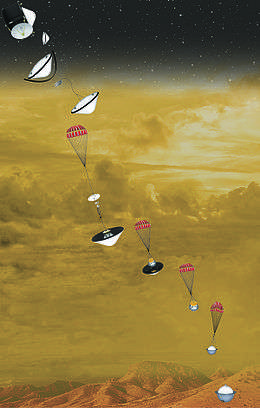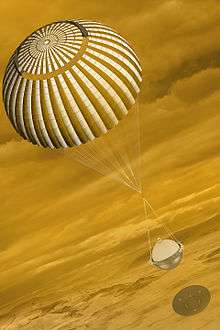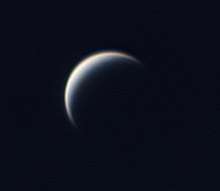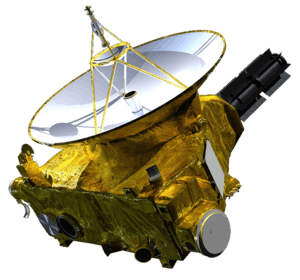DAVINCI
DAVINCI (Deep Atmosphere Venus Investigation of Noble gases, Chemistry, and Imaging) is a proposed mission concept for an atmospheric probe to Venus. It lost out to Psyche and Lucy in the 2015 round of proposals for NASA's Discovery Program. It was proposed again on 1 July 2019,[1] and shortlisted on 13 February 2020.
 Artist's concept of DAVINCI probe descent stages | |
| Mission type | Venus atmospheric probe |
|---|---|
| Operator | NASA Goddard Space Flight Center |
| Start of mission | |
| Launch date | ? |
| Venus atmospheric probe | |
DAVINCI would study the chemical composition of Venus' atmosphere during descent.[2][3] The DAVINCI probe would travel through the Venus atmosphere, sampling the air, and returning measurements down to the surface. These measurements are important to understanding the origin of the Venus atmosphere, how it has evolved, and how and why it is different from Earth and Mars. DAVINCI's measurements would reveal the history of water on Venus and the chemical processes at work in the unexplored lower atmosphere. Before it reaches the surface, the DAVINCI probe would take the first ever photos of the planet's intriguing, ridged terrain (“tesserae”) to explore its origin and tectonic, volcanic, and weathering history.
Proposal development
DAVINCI was one of the dozens of proposals submitted in 2015 to potentially become Mission #13 of NASA's Discovery Program. NASA's planned budget for Discovery Mission #13 is US$450 million. On September 30, 2015, it was selected as one of five finalists.[4] On January 4, 2017, two competing proposals, Lucy and Psyche, defeated DAVINCI to be selected as the 13th and 14th Discovery missions, respectively.[5]
The DAVINCI Principal Investigator is James B. Garvin of NASA's Goddard Space Flight Center.
Objectives
Following five orbital missions to Venus (Venera 15, Venera 16, Magellan, Venus Express, Akatsuki) focused on remote sensing observations, DAVINCI would be the first probe since 1986 to target Venus's atmosphere.[6] DAVINCI will directly measure the lower two-thirds of the atmospheric mass.
DAVINCI scientists would explore how Venus's atmosphere formed and then changed over time, including what happened to its water. The findings would help scientists understand why Venus and Earth took such different paths as they matured, and provide another point of comparison for studies of rocky planets in other star systems (exoplanets).
DAVINCI's in situ measurements would answer multiple questions regarding Venus's atmospheric composition as currently formulated for the National Research Council Planetary Science Decadal Survey's Venus In Situ Explorer (VISE).
Goals
- Atmospheric origin and evolution: Understand the origin of the Venus atmosphere, how it has evolved, and how and why it is different from the atmospheres of Earth and Mars.
- Atmospheric composition and surface interaction: Understand the history of water on Venus and the chemical processes at work in the lower Venus atmosphere.
- Surface properties: Provide insights into tessera origins and their tectonic, volcanic, and weathering history.
Scientific payload
DAVINCI is designed to address high-priority NASA decadal science by targeting noble gases, trace gases, and their isotopes, as well as temperature, pressure, winds, and imaging at Venus.

DAVINCI's Venus Analytic Laboratory (VAL) instruments would provide high-fidelity synergistic measurements throughout the probe's descent, particularly in the upper clouds and the unexplored near-surface environment. VAL design is based on the Sample Analysis at Mars (SAM) instrument on the Curiosity rover, which measured the chemical and isotopic composition of the Martian atmosphere, and found the first definitive evidence of organics on Mars.[7] DAVINCI's four science instruments are:
- Venus Mass Spectrometer (VMS)
Proposed to be built by NASA's Goddard Space Flight Center (GSFC), VMS would provide the first comprehensive in situ surveys of noble and trace gases at Venus, and has the capability to discover new gas species in the Venusian atmosphere. VMS is similar to Curiosity's Quadrupole Mass Spectrometer (QMS).
- Venus Tunable Laser Spectrometer (VTLS)
Proposed to be built by NASA's Jet Propulsion Lab (JPL), VTLS would provide the first highly sensitive in situ measurements of targeted trace gases and associated isotope ratios at Venus, addressing key science questions about chemical processes in the upper clouds and the near-surface environment. VTLS is similar to Curiosity's Tunable Laser Spectrometer (TLS).
- Venus Atmospheric Structure Investigation (VASI)
Proposed to be built by NASA's Goddard Space Flight Center (GSFC) using flight-proven sensors, VASI would provide measurements of the structure and dynamics of Venus' atmosphere during entry and descent, providing context for chemistry measurements and enabling reconstruction of the probe's descent.
- Venus Descent Imager (VenDI)
Proposed to be built by Malin Space Science Systems (MSS), VenDI would provide high-contrast images of the tessera terrain at the descent location. VenDI is similar to Curiosity's Mast Camera (Mastcam), Mars Descent Imager (MarDI), and Mars Hand Lens Imager (MAHLI).
See also
- Selection of Discovery Mission 13 and 14
- VERITAS (spacecraft), proposed Venus orbiter, which is also on the Discovery program shortlist
- Pioneer Venus Multiprobe, previous Venus atmospheric probe (1978)
- Galileo Probe, Galileo orbiter's Jupiter atmospheric probe (1995)
References
- Venus, Earth’s Evil Twin, Beckons Space Agencies. By Shannon Hall, Scientific American. 12 June 2019.
- Brown, Dwayne C.; Cantillo, Laurie (30 September 2015). "NASA Selects Investigations for Future Key Planetary Mission". NASA News. Washington, D.C. Retrieved 1 October 2015.
- "NASA announces five Discovery proposals selected for further study". The Planetary Society. 1 October 2015. Retrieved 1 October 2015.
- "Small Bodies Dominate NASA's Latest Discovery Competition". SpaceNews.com. Retrieved 2016-03-04.
- "NASA Selects Two Missions to Explore the Early Solar System". January 4, 2017. Retrieved January 4, 2017.
- "The DAVINCI spacecraft". phys.org. Retrieved 2016-03-04.
- Steigerwald, Bill. "NASA Goddard Instrument's First Detection of Organic Matter on Mars". NASA. Retrieved 2016-03-04.




